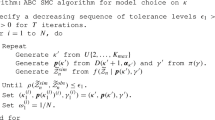Abstract
It is suggested that a useful component of a fertility simulation would be proportions of females sterile by age. Data on this phenomenon are rather limited, but they indicate that proportional sterility may not easily be described by a simple function. We propose that rates of becoming sterile may be adequately described by an exponential function utilizing proper parameter values. Such exponential-model rates form the basis for computation of a fecundity decrement table presented in this paper. Sterility proportions from the table are compared to some empirical data.
Similar content being viewed by others
References
Barrett, J. C. 1971. Use of a Fertility Simulation Model to Refine Measurement Techniques. Demography 8: 481–490.
Henry, Louis. 1953. Fécondité des Mariages: Nouvelle Méthode de Mesure. Institut National d’Etudes Demographiques, Travaux et Documents. Cahier 16. Paris.
—. 1961. Some Data on Natural Fertility. Eugenics Quarterly 8:81–91.
—. 1966. French Statistical Research in Natural Fertility. In Mindel C. Sheps and Jeanne C. Ridley (eds.), Public Health and Population Change: Current Research Issues. Pittsburgh: University of Pittsburgh Press.
Holmberg, Ingvar. 1970. Fecundity, Fertility, and Family Planning: Application of Demographic Micromodels, I. University of Gothenburg, Demographic Institute, Reports, 10. Gothenburg, Sweden: Almqvist & Wiksell,
Ireland, Central Statistics Office. 1961. Census of the Population of Ireland: 1961. Vol. VIII, Fertility of Marriage. Dublin: The Stationery Office.
Japan. Bureau of Statistics. 1964. 1960 Population Census of Japan, Ten Per Cent Sample Tabulation. Part 3, Fertility. Tokyo.
Kale, B. D. 1970. A Female Fecundity Table. Pp. 226–239 In Ashish Bose, P. B. Desai, and S. P. Jain (oomps.), Stu-dies in Demography: Essays Presented to Professor S. Chandrasekhar on His Fifty-First Birthday. Chapel Hill: University of North Carolina Press.
New Zealand. 1918. Results of a Census of the Dominion of New Zealand, Taken for the Night of the 15th October, 1916. Part VIII, Fertili ty. Wellington.
Sjöstrand, Johannas. 1940. Den Xktenskapliga Fruksamheten I Sverige. Stockholm: Akademisk Avhandung.
Vincent, Paul. 1950. La Sterilite Physiologique des Populations. Population 5:45–64.
U. S. Bureau of the Census. 1947. Census of the Population: 1940. Special Reports. Differential Fertility 1940 and 1910, Fertility by Duration of Marriage. Washington, D. C.: Government Printing Office.
Author information
Authors and Affiliations
Rights and permissions
About this article
Cite this article
Pittenger, D.B. An exponential model of female sterility. Demography 10, 113–121 (1973). https://doi.org/10.2307/2060754
Issue Date:
DOI: https://doi.org/10.2307/2060754




